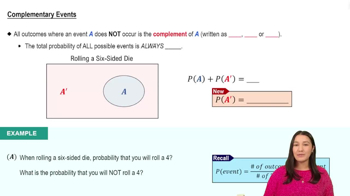Table of contents
- 1. Introduction to Statistics53m
- 2. Describing Data with Tables and Graphs2h 1m
- 3. Describing Data Numerically1h 48m
- 4. Probability2h 26m
- 5. Binomial Distribution & Discrete Random Variables2h 55m
- 6. Normal Distribution & Continuous Random Variables1h 48m
- 7. Sampling Distributions & Confidence Intervals: Mean1h 17m
- 8. Sampling Distributions & Confidence Intervals: Proportion1h 20m
- 9. Hypothesis Testing for One Sample1h 8m
- 10. Hypothesis Testing for Two Samples2h 8m
- 11. Correlation48m
- 12. Regression1h 4m
- 13. Chi-Square Tests & Goodness of Fit1h 30m
- 14. ANOVA1h 4m
4. Probability
Complements
Struggling with Statistics for Business?
Join thousands of students who trust us to help them ace their exams!Watch the first videoMultiple Choice
When drawing a marble out of a bag of red, green, and yellow marbles 8 times, a red or yellow marble is drawn 6 times. What is the probability of drawing a green marble?
A
0.025
B
0.125
C
0.25
D
0.75
 Verified step by step guidance
Verified step by step guidance1
Step 1: Understand the problem. We have a bag of marbles with three colors: red, green, and yellow. We know that a red or yellow marble is drawn 6 times out of 8 draws.
Step 2: Calculate the number of times a green marble is drawn. Since red or yellow marbles are drawn 6 times, the remaining draws must be green marbles. Therefore, the number of green marbles drawn is 8 - 6 = 2.
Step 3: Determine the probability of drawing a green marble. Probability is calculated as the number of successful outcomes divided by the total number of trials. Here, the successful outcome is drawing a green marble, which happened 2 times out of 8 draws.
Step 4: Set up the probability formula. The probability of drawing a green marble is given by: \( P(\text{green}) = \frac{\text{Number of green marbles drawn}}{\text{Total number of draws}} = \frac{2}{8} \).
Step 5: Simplify the fraction to find the probability. Simplify \( \frac{2}{8} \) to its lowest terms to find the probability of drawing a green marble.

 4:23m
4:23mWatch next
Master Complementary Events with a bite sized video explanation from Patrick
Start learningRelated Videos
Related Practice

